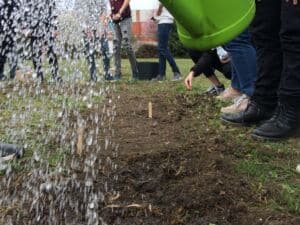Location: Hungary
Lead Partner: ESSRG
Involved partners:
environmental education experts, at least two school gardens, one in the Budapest agglomeration and another in the Eastern Hungarian countryside
What role does the education system have in raising awareness and empowering the youth to raise their voice and act for a better future?
ESSRG mapped the institutional landscape and analysed why there was a (lack of) emphasis on the environmental crisis in high schools, and how far individual scientific subjects (either as curricula, or offered as extracurricular activities) could support awareness raising on biodiversity.
ESSRG tries to find answers through action research focusing on: Why is it important for children at different ages to have biodiversity education? Can it influence a transformative change? Can the whole public education system introduce biodiversity education in a more integrated manner, not in siloes?
The case has a strong political dimension. Is transformative change even possible to achieve in a context of strong centralisation and power asymmetry?

School garden in Hungary Photo: Janka Horváth
Expected impacts
Individual level
Environmental awareness and attitudes can be formed through experiential learning at young ages, which can later have an impact on adult behaviour.
Community level
More room to biodiversity in Hungarian education by implementing practice-based and experiential learning to understand and appreciate biodiversity and to foster collaborative action at community level.
More schools are establishing school gardens or similar interventions to foster practice-based learning.
Institutional/Policy level
Sharing the best practices of the partner schools can have a wider impact on how other schools teach biodiversity related topics and how the National Curricula integrates biodiversity into its objectives.
Biodiversity
In the school gardens themselves, there is a potential for multiplication of agrobiodiversity in other sectors, eg. home gardening and urban green spaces.
Intersectionality dimensions
- Gender aspect: biodiversity education experts are usually women (hypothesis: do girls have a more positive attitude towards Nature?)
- Age: primary and secondary schools follow very different curricula, secondary education allocating significantly less time to outdoor activities. Openness and abilities to understand complex scientific subjects are different across ages, therefore teaching biodiversity to young children versus teenagers should be approached differently.
- Social status: Hungary is unequal in terms of education (social status dynamics). Communities with better socio-economic background and higher social status live in or around Budapest, therefore children in schools around the capital are usually from higher social classes. On the other hand, in marginalised rural areas a large segment of local communities are less affluent (i.e., the proportion of unemployed or Roma people is higher). Limited access to nature is possible in both urban and rural settings, but we assume that different social backgrounds might have different impacts of how children perceive this limited access to nature.
Working approach
- Identifying and assessing best practices for biodiversity education
- Policy analysis
- Key informant interviews (biodiversity education experts)
- Assessing the impacts of Hungarian school gardens through surveys, observation and deliberative methods (e.g., photovoice)
Publications and links
